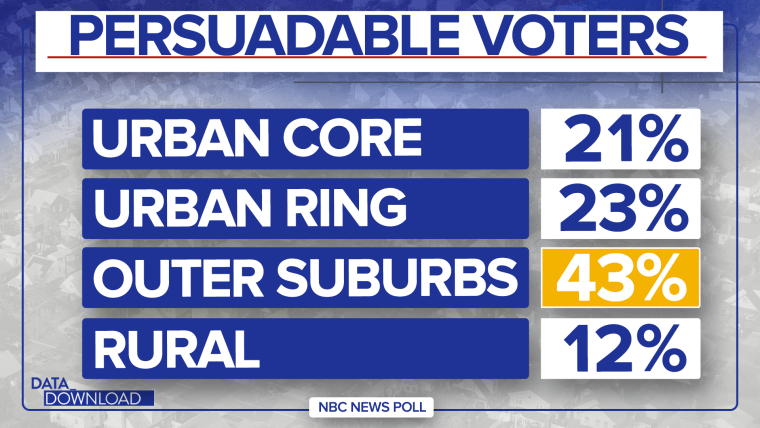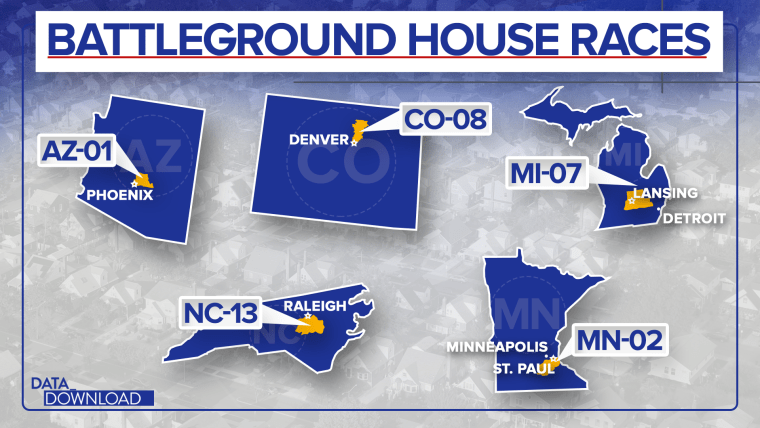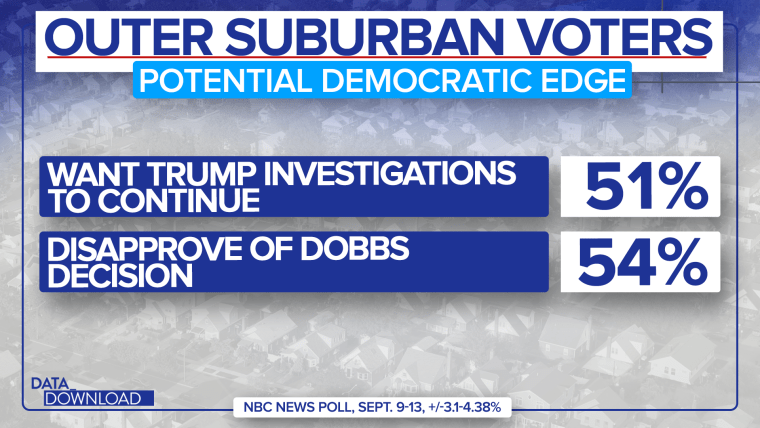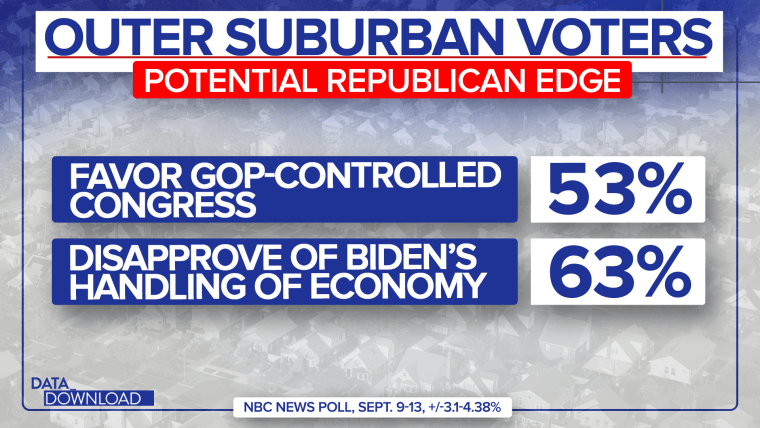In every election, there are solid Democratic voters and solid Republican voters — and then there are the voters who are less sure of where they stand. Those persuadable voters are often the difference between winning and losing and the NBC News poll shows they are a distinct group that tends to be concentrated in distinct areas.
There are persuadable voters everywhere, but the NBC News poll has consistently shown they are most heavily based in outer suburb counties. Those 1,100 counties hold a plurality of the nation’s up-for-grabs electorate.

This year the NBC News poll finds that 43% of all persuadable voters live in those outer suburbs, far more than other areas. Together the nation’s big city urban core counties and the near-in urban ring counties hold about the same number of persuadable voters. Rural counties only hold about 12% of the nation’s persuadables.
And that outer suburb base for persuadable voters is not new. Going back to 2010, those outer ring suburb counties have held 42% or 43% of the persuadable vote. In short, the cities belong to the Democrats and rural America belongs to the Republicans, but the space between is where you are most likely to find voters who are weighing their alternatives.
These kinds of counties exist in states across the country. The nation’s largest cities are marked by sprawl and when the sprawl grows the outer suburbs can become a political force. In 2022, there are a few congressional districts where their impact might be especially notable.

In Arizona, the 1st Congressional District includes Phoenix and a massive swath of land to the north and east. The Cook Political Report currently rates the race as “Lean Republican.”
And there is a long list of races the Cook Report considers to be toss-ups that share some of the same kind of suburban/exurban geography. In Colorado, the 8th District stretches north from the Denver suburbs up toward Fort Collins. In Michigan, the 7th District runs out from the western suburbs of Detroit up into and around greater Lansing, the state capital. Minnesota’s 2nd District comes out of suburban St. Paul and stretches down to the state’s southern border. And in North Carolina, the 13th District flows south out of Raleigh and the Research Triangle area into its sprawl.
To be clear these are not purely “suburban” districts. They are the kinds of places where the edges of urban American give way to newly built subdivisions, lots that are for sale and sparsely populated rural land. But it’s that kind of terrain and population that makes them 2022 battlegrounds.
Are there signs of where the outer suburb voters might end up in November in the latest poll? There are arguments for both parties in the numbers.
For the Democrats, there are positives around how these voters feel about former President Donald Trump and abortion.

The poll finds that 51% of the voters in the outer suburbs believe investigations into alleged wrongdoing by Trump should continue. And a majority of the voters in those outer suburbs, 54%, say they disapprove of the Supreme Court’s Dobbs decision that overturned Roe v. Wade and took away the national right to abortion.
Those numbers are lower than the overall figures for those topics, but they’re much higher than where Republicans are on those issues and they could be read as a slight Democratic advantage among those voters.
But there are other numbers in the poll that suggest a Republican edge in the outer suburbs when one looks at the generic ballot and at how voters in these counties feel about President Joe Biden’s handling of the economy.

A little more than half of the voters who live in the outer suburbs, 53%, say they prefer that this fall’s election produces a GOP-controlled Congress. That’s much lower than the number for Republicans, but a bit higher than the overall figure. And 63% of voters in the outer suburbs say they disapprove of Biden’s handling of the economy, a bit higher than voters overall.
But reading answers into those numbers is not easy. Most voter decisions end up being binary (Democrat or Republican) but the decision-making process is not simple. The decision is usually the result of a complicated stew of factors.
And the way the voters in the outer suburbs sort through these issues — abortion versus the economy, feelings about Trump versus feelings about Biden — could be end up being crucial in the House races above. They will also likely be an important dynamic in statewide contests such as the senate and gubernatorial races in Georgia, North Carolina, Arizona and Florida, states with lots of sprawl around their major cities and lots of outer suburb voters.
Of course, persuadable voters won’t be the only important factor this fall. This summer’s Dobbs decision on abortion has shaken up polling and could fundamentally shift the electorate by changing its composition. Who actually votes is a huge part of any election, but it’s especially important in midterm years.
But persuadables almost always play an important role in the final results, and if you want a sense of where they stand and what impact they’re having keep an eye on those districts and edges of metro areas around the country.